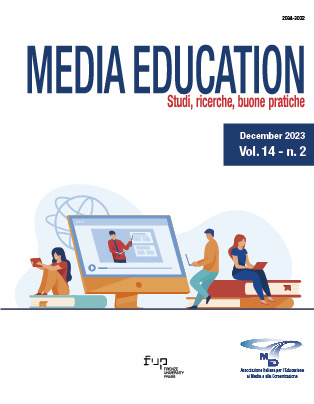Published 2023-12-31
Keywords
- immersive environment,
- museum education,
- gamification,
- instructional design
Copyright (c) 2023 Cristina Gaggioli, Chiara Mancini

This work is licensed under a Creative Commons Attribution 4.0 International License.
Abstract
The contribution proposes a reflection on the design of educational paths in immersive environments, starting with the presentation of “The age of Pompeii,” an immersive and gamified museum educational path, aimed at increasing the dialogue between the artistic-cultural heritage of the archaeological park of Pompei and children under 18. The contribution describes the characterizing design elements of the educational path, with particular reference to those concerning learning design, universal design and game design. The challenge is to be able to identify the elements that can make an immersive learning environment not only educational, but also engaging and inclusive.
References
- Briggs, L.J. (ed.) (1977). Instructional Design: principles and applications. Educational Technology Publications.
- Caponetto, I., Earp, J. & Ott, M. (2014). Gamification and education: A literature review. In European Conference on Games Based Learning, vol. 1 (pp 50-57). Academic Conferences and Publishing International Limited.
- CAST (2011). Universal Design for Learning (UDL) Guidelines version 2.0. https://udlguidelines.cast.org
- Choi, D.H., Dailey-Hebert, A. & Estes, J.S., (Eds.) (2016). Emerging tools and applications of virtual reality in education. IGI Global. DOI: https://doi.org/10.4018/978-1-4666-9837-6
- Chou, Y.K. (2019). Actionable gamification: Beyond points, badges, and leaderboards. Packt Publishing Ltd.
- Clark, D.B., Tanner-Smith, E.E. & Killingsworth, S.S. (2016). Digital games, design, and learning: A systematic review and meta-analysis. Review of Educational Research, 86(1), 79-122. https://10.3102/0034654315582065 DOI: https://doi.org/10.3102/0034654315582065
- Cuomo, S., Roffi, A., Luzzi, D. & Ranieri, M. (2022). Immersive Environments in Higher Education: The Digital Well-Being Perspective. In Ranieri, M., Pellegrini, M., Menichetti, L., Roffi, A. & Luzzi, D. (Eds.). Social Justice, Media and Technology in Teacher Education: 27th ATEE Spring Conference, ATEE 2021, Florence, Italy, October 28–29, 2021, Revised Selected Papers (pp 30-41). Springer. DOI: https://doi.org/10.1007/978-3-031-20777-8_3
- Deterding, S., Khaled, R., Nacke, L.E. & Dixon, D. (2011). Gamification: Toward a definition. Paper presented at the CHI 2011 Gamification Workshop Proceedings Vancouver, 2011 (pp. 12-15). ACM.
- Freina, L. & Ott, M. (2015). A literature review on immersive virtual reality in education: State of the art and perspectives. The international scientific conference e-learning and software for education, vol.1, n.133. https://10.12753/2066-026X-15-020 DOI: https://doi.org/10.12753/2066-026X-15-020
- Gaggioli, C. (2022). La classe oltre le mura. Gamificare per includere. Franco Angeli.
- Gee, J.P. (2005). Why video games are good for your soul: Pleasure and learning. Common Ground.
- Kavanagh, S., Luxton-Reilly, A., Wuensche, B. & Plimmer, B. (2017). A systematic review of Virtual Reality in education. Themes in Science and Technology Education, 10(2), 85-119.
- Kuo A., Hiler J.L. & Lutz R.J. (2017). From Super Mario to Skyrim: A framework for the evolution of video game consumption. Journal of Consumer Behaviour, 16(2), 101-120. DOI: https://doi.org/10.1002/cb.1620
- Lee E.A.L. & Wong K.W. (2014). Learning with desktop virtual reality: Low spatial ability learners are more positively affected. Computers & Education, 79, 49-58. DOI: https://doi.org/10.1016/j.compedu.2014.07.010
- Luigini, A. & Panciroli, C (Eds.) (2018). Ambienti digitali per l’educazione all’arte e al patrimonio. Franco Angeli.
- Mor Y. & Winters N. (2007). Design approaches in technology-enhanced learning. Interactive Learning Environments, 15(1), 61-75. DOI: https://doi.org/10.1080/10494820601044236
- Nah F.F.H., Zeng Q., Telaprolu V.R., Ayyappa A.P. & Eschenbrenner B. (2014). Gamification of education: A review of literature. In Nah F.F.H. (Ed.), HCI in Business. First international conference, HCIB 2014 (pp 401-409). Springer. DOI: https://doi.org/10.1007/978-3-319-07293-7_39
- Paniagua, A. & Istance D. (2018). Teachers as Designers of Learning Environments: The Importance of Innovative Pedagogies, OECD Publishing. https://10.1787/9789264085374-en DOI: https://doi.org/10.1787/9789264085374-en
- Panciroli, C. & Macauda, A. (2019). Spazi digitali per educare al Patrimonio: il MOdE, Museo Officina dell’Educazione. In Poce, A. (Ed.), Studi avanzati di educazione museale. Lezioni (pp 49-62). Edizioni Scientifiche Italiane.
- Panciroli, C. & Manini, M. (2010). Musei reali e i musei virtuali dell’educazione: Sinergie da costruire. Introduzione. Ricerche di pedagogia e didattica, 5(2), 385-389.
- Punie, Y. (Ed.), Redecker, C. (2017). European Framework for the Digital Competence of Educators: DigCompEdu. Publications Office of the European Union, Luxembourg. https://data.europa.eu/doi/10.2760/159770
- Rosemblum, L.J. & Cross, R.A. (1997). The challenge of virtual reality. In Earnshaw, R., Vince, J. & Jones, H. (Eds.), Visualization and modeling (pp 325–339). Academic press.
- Tartarini, C. (2016). Didattica museale. Sulle tracce di un dilettevole spaesamento. I quaderni di PsicoArt, 7. Arte e psicologia. Contributi e riflessioni, 235-258.
- Williams-Bell F.M., Kapralos B., Hogue A., Murphy B.M. & Weckman E.J. (2015). Using serious games and virtual simulation for training in the fire service: a review. Fire Technology, 51, 553-584. DOI: https://doi.org/10.1007/s10694-014-0398-1
- Wouters P., van Nimwegen C., van Oostendorp H. & van der Spek E.D. (2013). A meta-analysis of the cognitive and motivational effects of serious games. Journal of Educational Psychology, 105(2), 249-265. https://10.1037/a0031311 DOI: https://doi.org/10.1037/a0031311

